Oil
- Crude oil has been under selling pressure in recent weeks. WTI oil tested levels below 76 USD per barrel, and Brent below 79 USD per barrel
- US crude oil inventories are falling, but inventories of petroleum products remain stable.
- Comparative inventories in the US suggest oil being oversold. On the other hand, backwardation appears excessively high, so there is potential for a stronger price drop at the short end of the curve, which could reduce backwardation below 1 dollar on the nearest contracts
- Oil is under pressure ahead of the OPEC+ agreement review committee meeting. This meeting will take place on August 1st, and OPEC+ is not expected to change its decision, even despite oil prices remaining very low
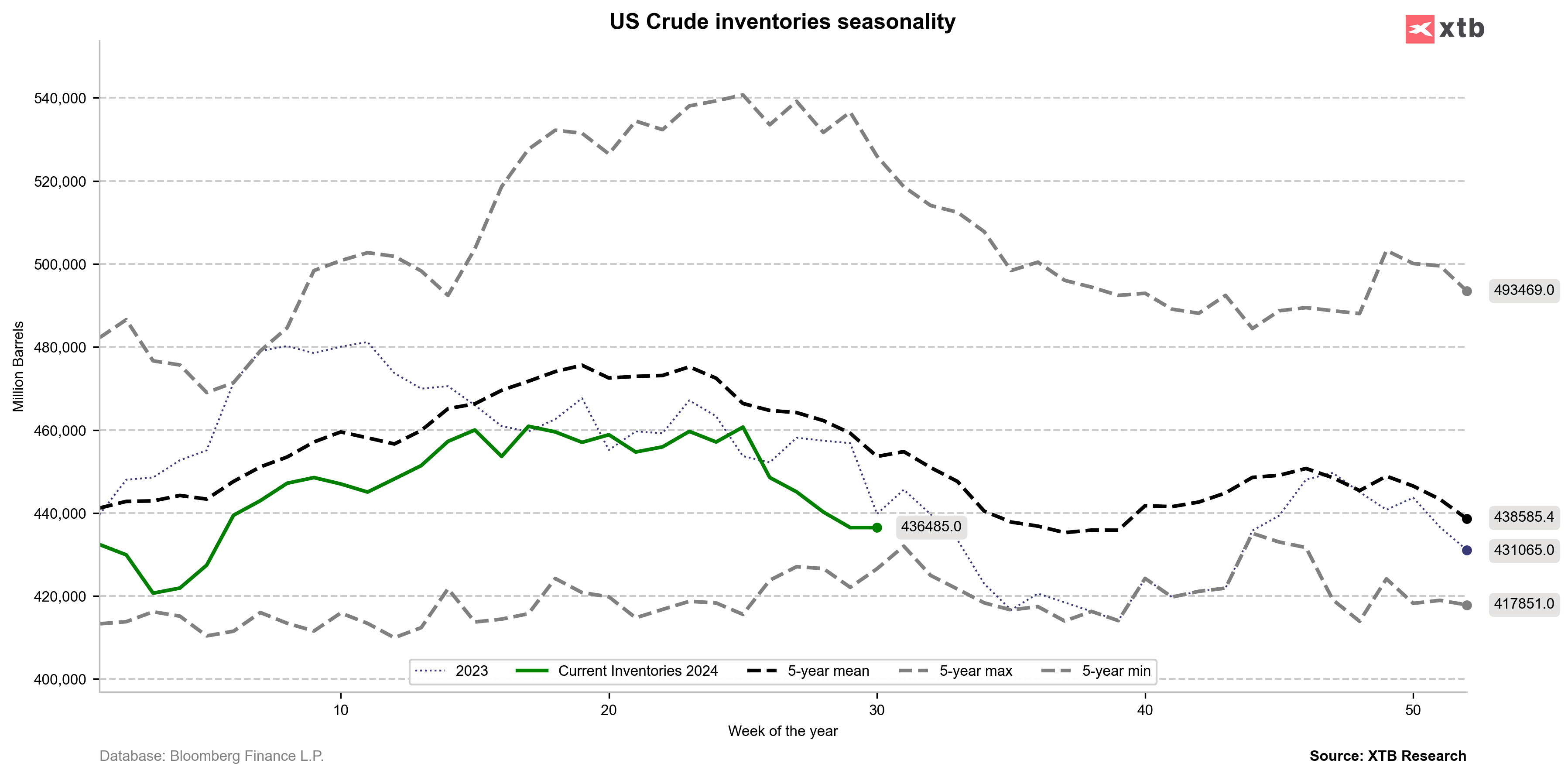 Oil inventories are falling more sharply than the 5-year average. On the other hand, inventories of petroleum products remain in consolidation. Source: Bloomberg Finance LP, XTB
Oil inventories are falling more sharply than the 5-year average. On the other hand, inventories of petroleum products remain in consolidation. Source: Bloomberg Finance LP, XTB
Start investing today or test a free demo
Create account Try a demo Download mobile app Download mobile app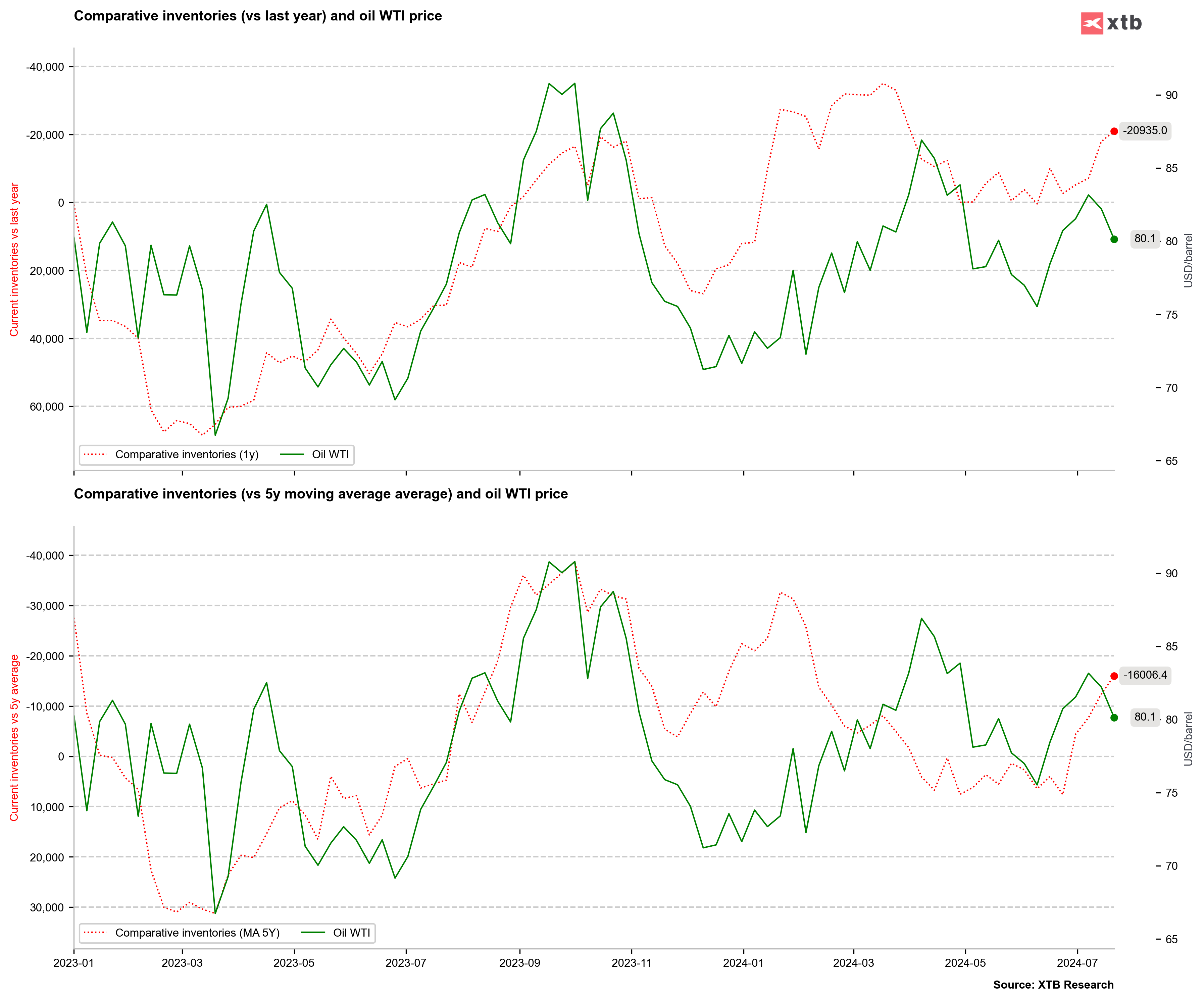 Comparative inventories indicate possible excessive selling of oil. Source: Bloomberg Finance LP, XTB
Comparative inventories indicate possible excessive selling of oil. Source: Bloomberg Finance LP, XTB
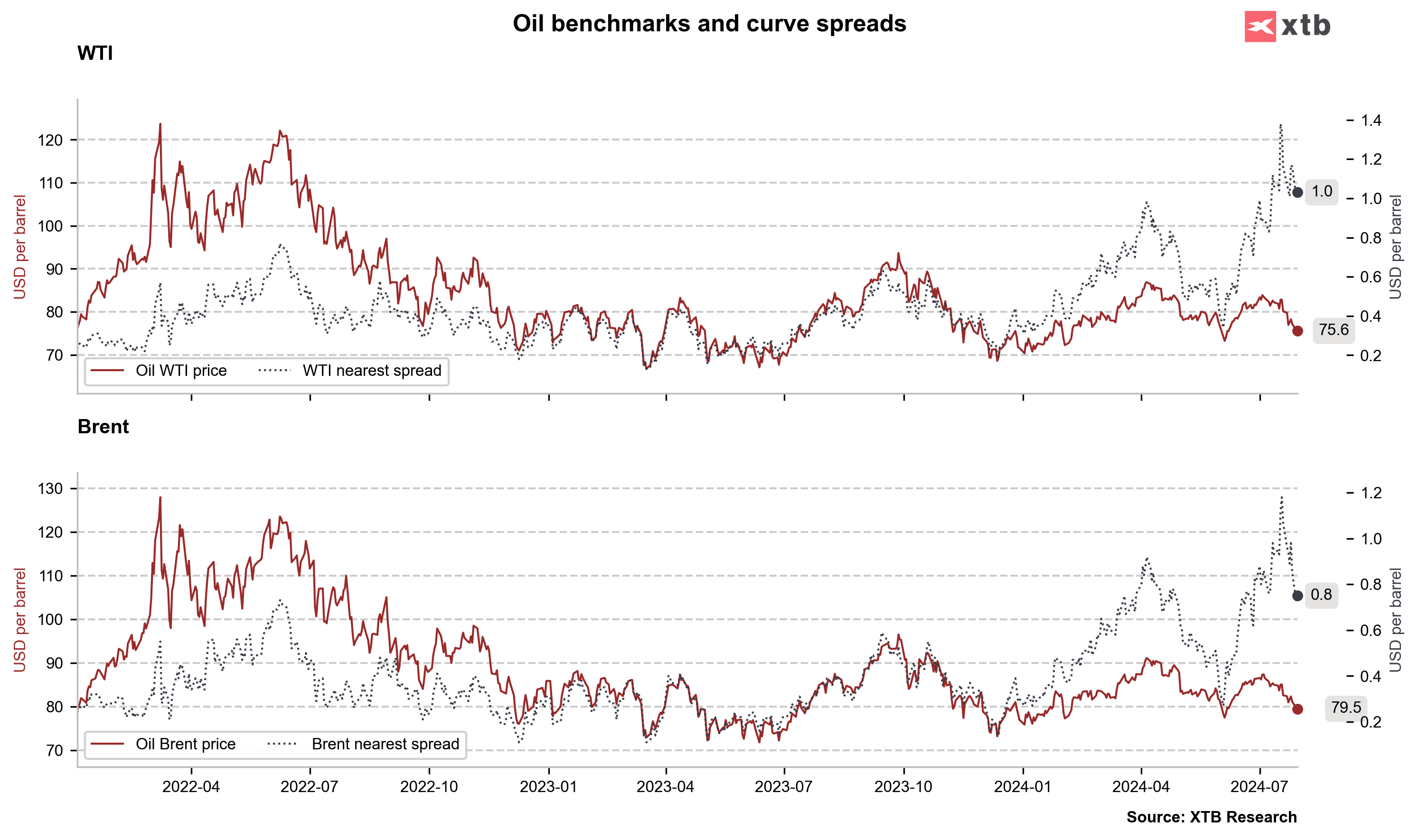 At the same time, we are still observing strong backwardation in the oil market, which may decrease in the near future. Backwardation at the level of 0.2-0.4 USD per barrel would provide a potential signal of excessive selling. Source: Bloomberg Finance LP, XTB
At the same time, we are still observing strong backwardation in the oil market, which may decrease in the near future. Backwardation at the level of 0.2-0.4 USD per barrel would provide a potential signal of excessive selling. Source: Bloomberg Finance LP, XTB
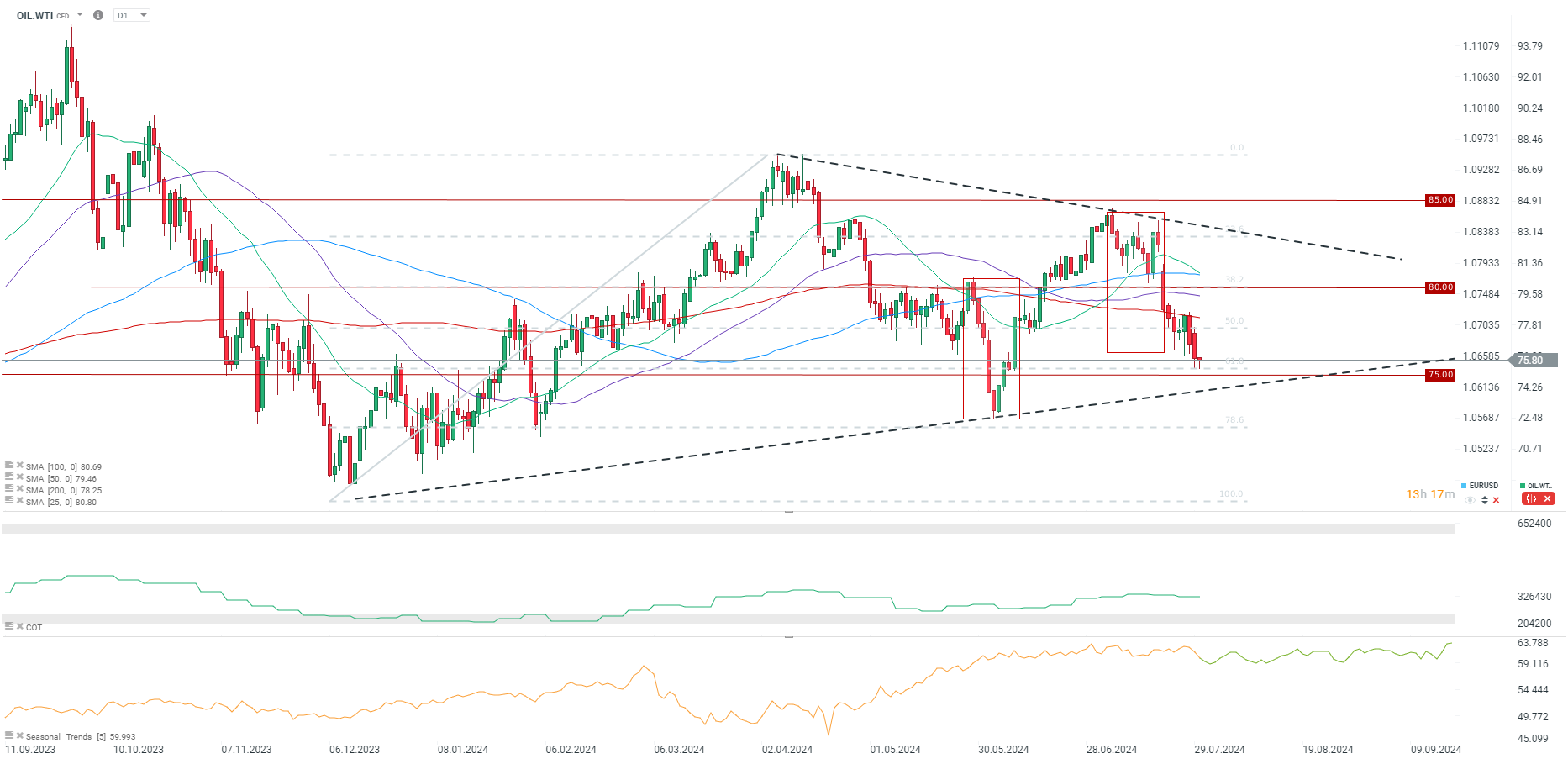 WTI oil falls below 76 USD per barrel. A very important demand zone is currently being tested. Falling below 75 USD per barrel could lead to a deeper pullback, although the last defensive barrier remains in the form of an upward trend line. Source: xStation5
WTI oil falls below 76 USD per barrel. A very important demand zone is currently being tested. Falling below 75 USD per barrel could lead to a deeper pullback, although the last defensive barrier remains in the form of an upward trend line. Source: xStation5
Natural Gas (NATGAS)
- We are observing the largest contango on the natural gas market since 2006-2008 when looking at the difference between the current contract and the end of the year
- Technically, NATGAS is defending the level of USD 2.0/MMBTU and potentially forming a double bottom pattern
- Net positions in gas remain at a relatively high level (though there is still a significant predominance of short positions over long ones). Nevertheless, the change in positions does not justify recent price changes.
- Comparative inventories are falling, although there is still a significant oversupply compared to the 5-year average and levels from a year ago. Production is clearly returning above 100 bcfd, so we should expect a greater increase in inventories in the near future
- The weather for the next few days indicates a return to high temperatures, so a slightly higher usage of gas in the U.S. cannot be ruled out in the coming days
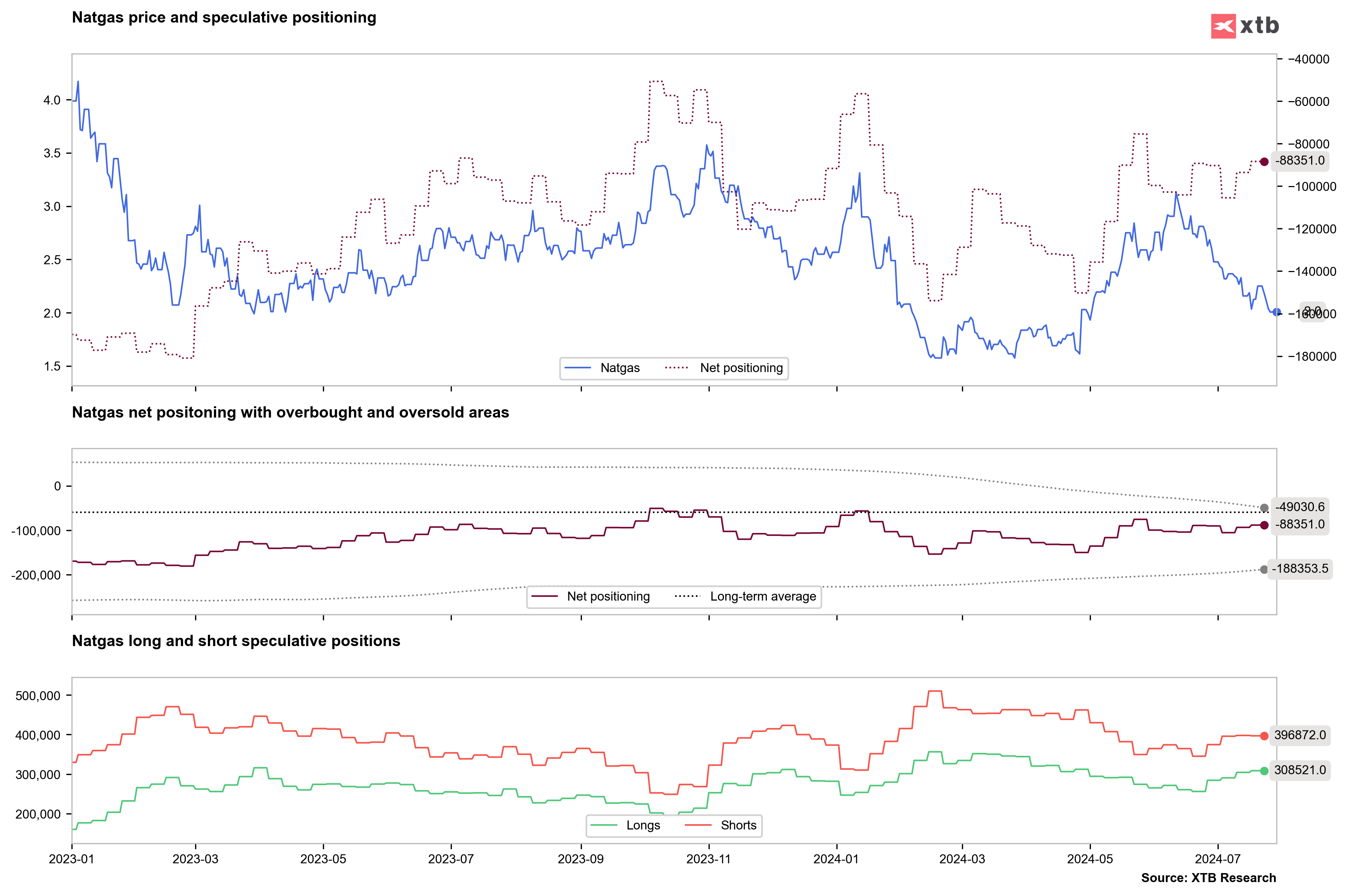 Positioning in gas has not changed recently, despite clear price declines. This may indicate a lack of capitulation from buyers, who have slightly increased the number of positions recently. Source: Bloomberg Finance LP, XTB
Positioning in gas has not changed recently, despite clear price declines. This may indicate a lack of capitulation from buyers, who have slightly increased the number of positions recently. Source: Bloomberg Finance LP, XTB
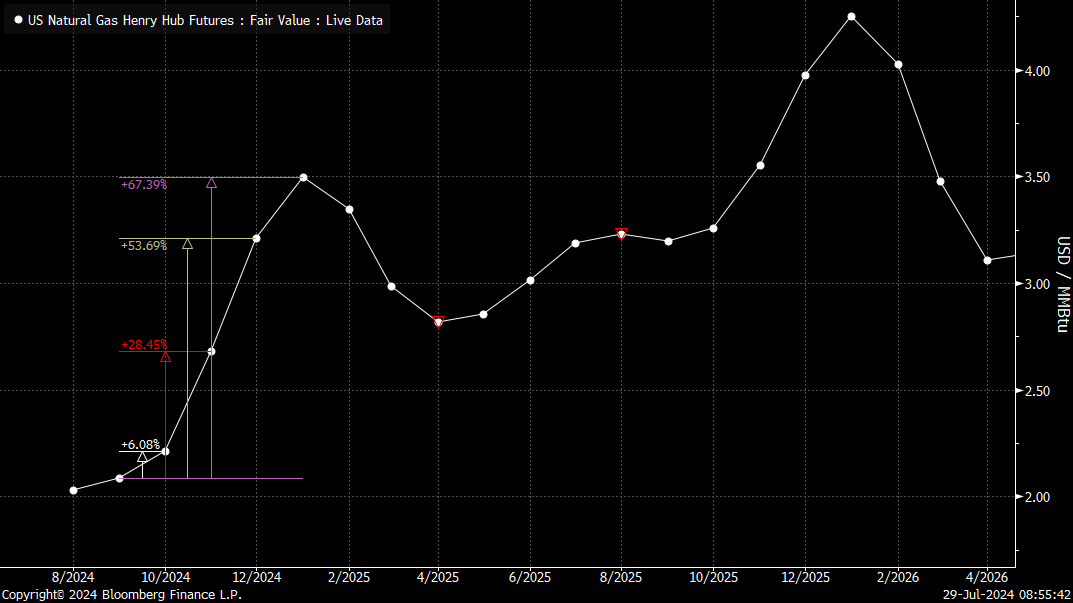 Contango in the gas market is extremely high. However, if comparative inventories continue to fall, there is a chance it will decrease in the coming months. Source: Bloomberg Finance LP, XTB
Contango in the gas market is extremely high. However, if comparative inventories continue to fall, there is a chance it will decrease in the coming months. Source: Bloomberg Finance LP, XTB
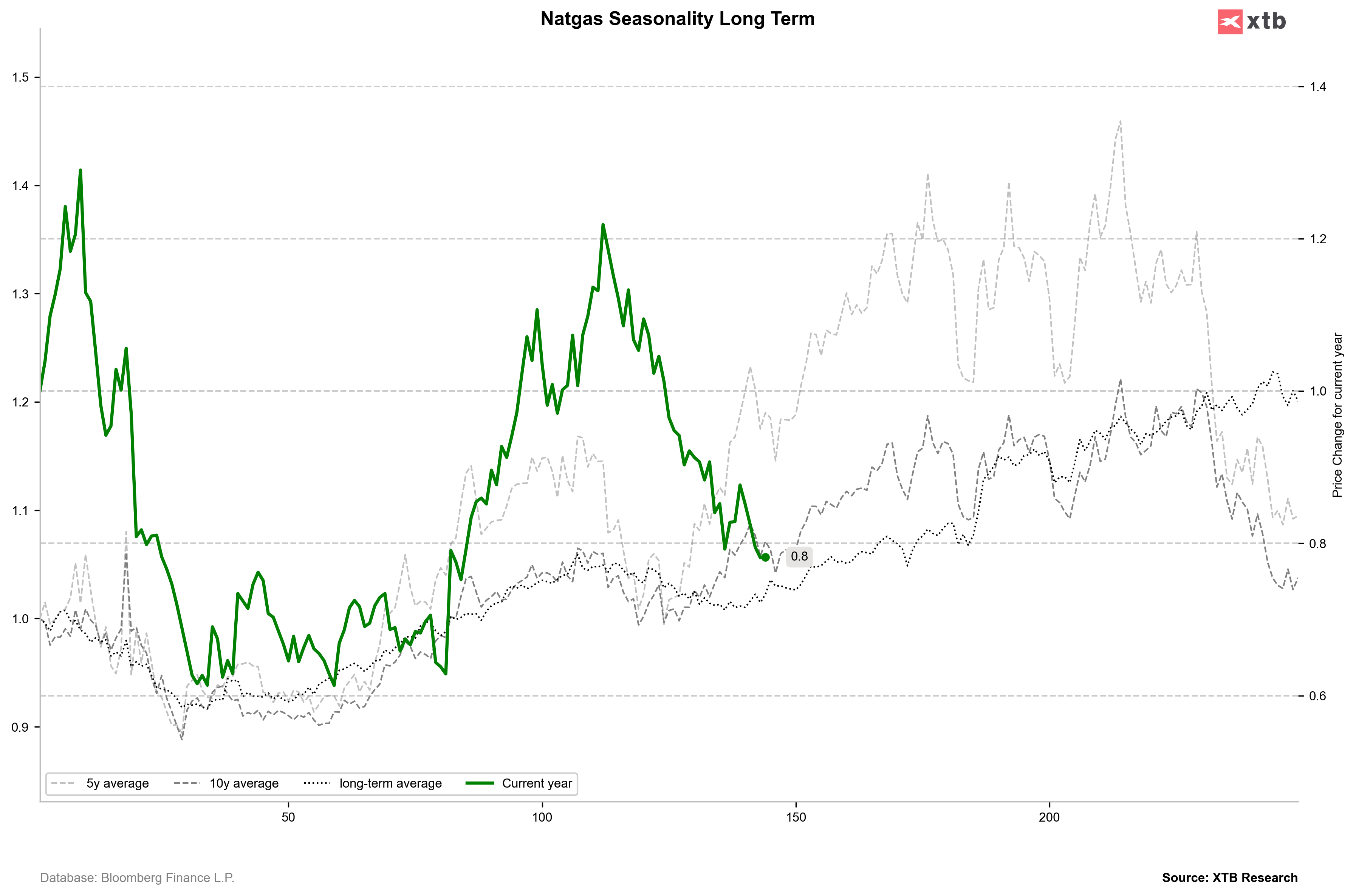 Seasonality in the gas market indicates that prices should rise in the latter part of the year. However, it should be remembered that this is largely due to the shape of the futures curve. Average increases from current levels to the end of this year are smaller than would result from rollovers alone. Source: Bloomberg Finance LP, XTB
Seasonality in the gas market indicates that prices should rise in the latter part of the year. However, it should be remembered that this is largely due to the shape of the futures curve. Average increases from current levels to the end of this year are smaller than would result from rollovers alone. Source: Bloomberg Finance LP, XTB
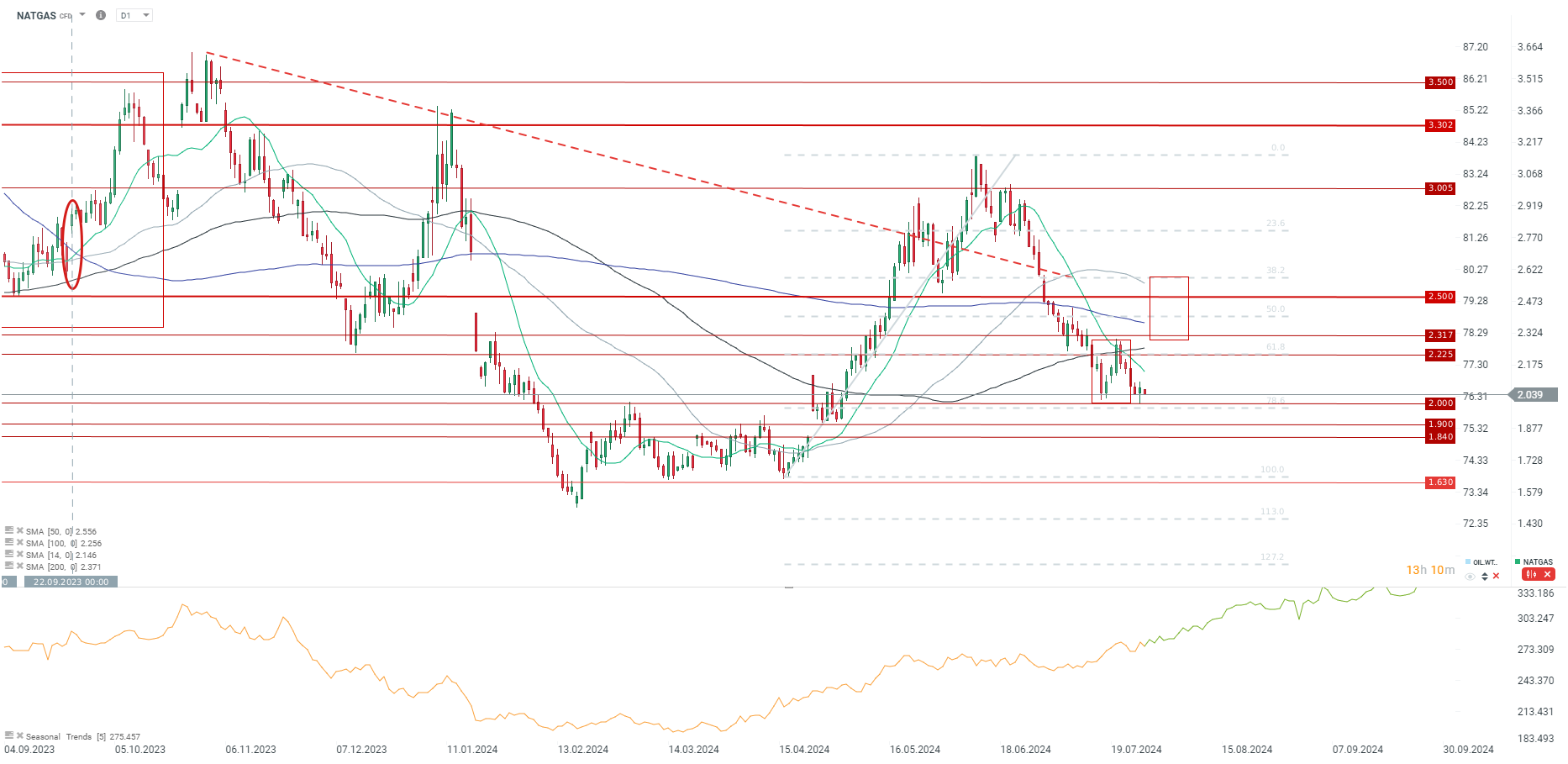 Natural gas is defending the level of USD 2.0/MMBTU. If the price rebounds and climbs above the 13-period average, then there is a chance to test the $2.30 area (potential neckline). However, if declines continue, the key demand zone is between $1.84 and $1.90. Source: xStation5
Natural gas is defending the level of USD 2.0/MMBTU. If the price rebounds and climbs above the 13-period average, then there is a chance to test the $2.30 area (potential neckline). However, if declines continue, the key demand zone is between $1.84 and $1.90. Source: xStation5
Cocoa
- The 2023/2024 season was the worst in terms of the cocoa market deficit, which was linked to weather factors, a lack of fertilizers in recent years, as well as insufficient funding
- El Nino was one of the factors that led to reduced yields. However, we may now experience a completely different situation due to the La Nina weather phenomenon, which could bring positive changes for farmers in Africa
- La Nina is likely to bring significant rainfall in August and September. Marex, a group providing services for companies in the commodity market, indicates we may experience a surplus in the market that next year, after three years of deficit
- However, it is crucial that increased rainfall occurs just before the proper season starts, which is before October. If the rains occur, for example, in November-December, it could worsen the recent situation and reverse the recent downward trend in the cocoa market, bringing prices back above USD 10,000
- La Nina, however, poses a threat to Ecuador – the largest cocoa producer in South America. La Nina is also negative for coffee production on this continent, but it is positive for coffee production in Asia.
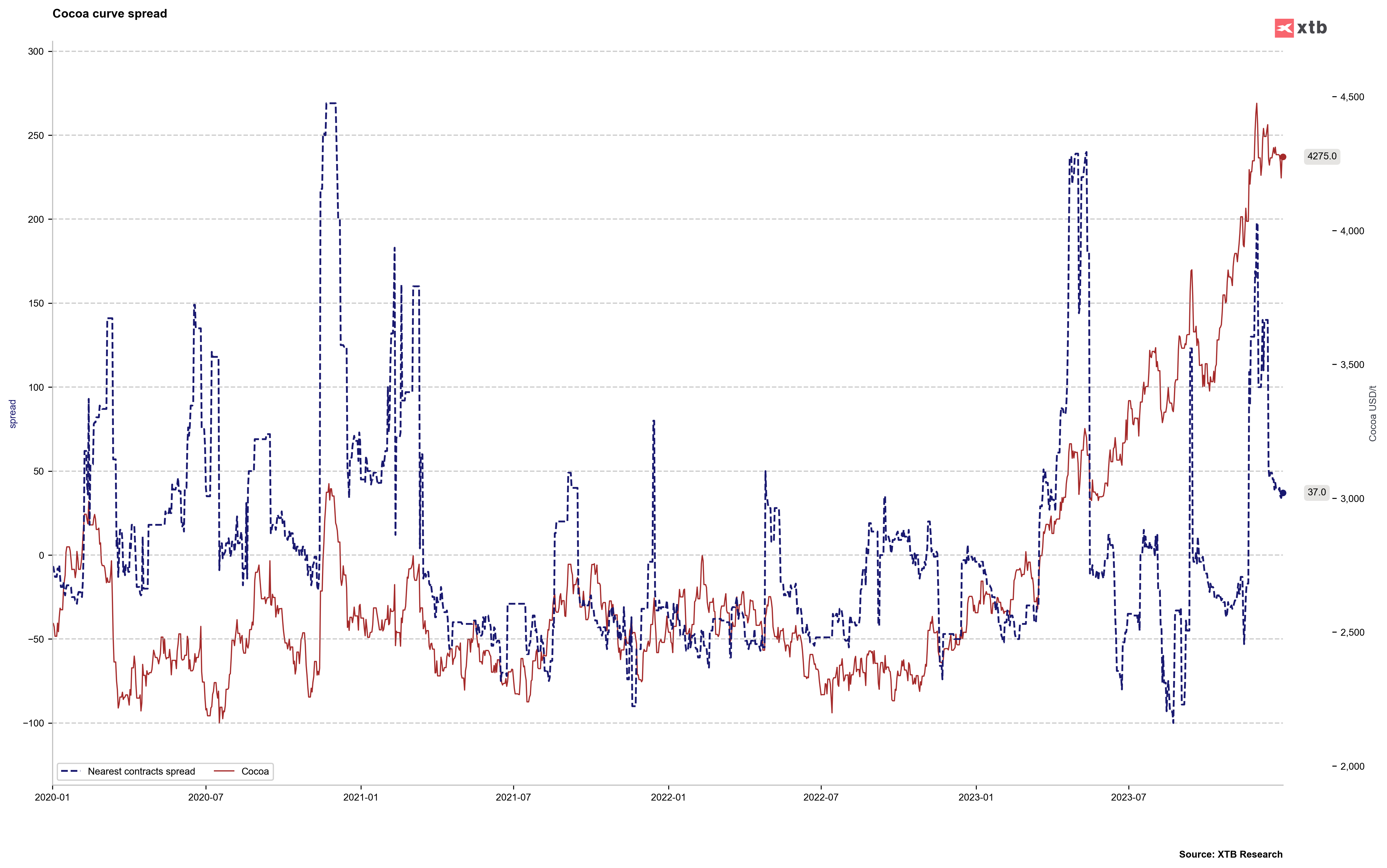 The difference between the nearest cocoa contracts remains relatively low but not enough to suggest a change in the futures curve and trigger a potential bullish signal, as was the case, for example, a year ago. Source: Bloomberg Finance LP, XTB
The difference between the nearest cocoa contracts remains relatively low but not enough to suggest a change in the futures curve and trigger a potential bullish signal, as was the case, for example, a year ago. Source: Bloomberg Finance LP, XTB
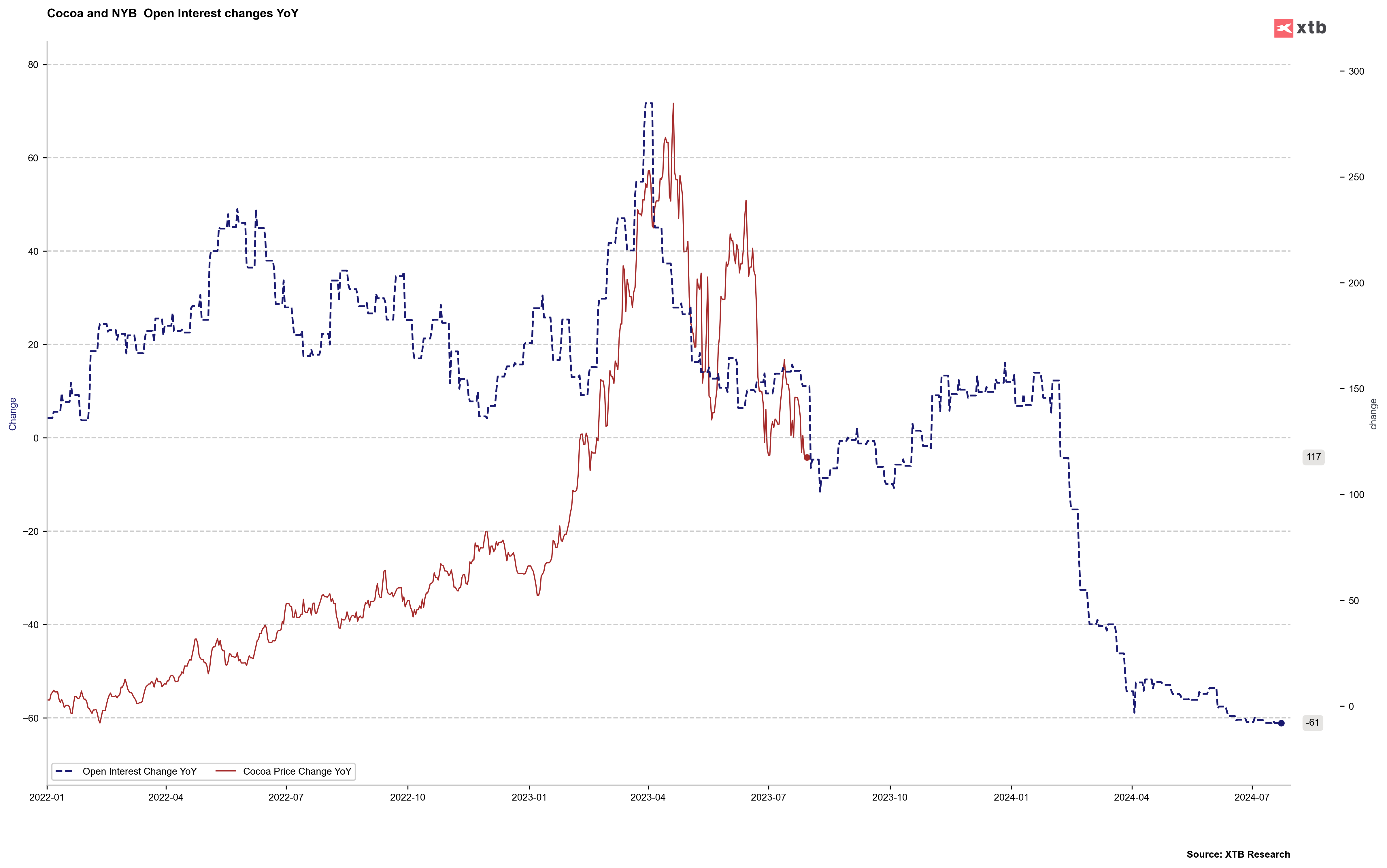 The change in the number of open positions compared to the price change theoretically shows potential for consolidation in the coming months, before a significant decline at the turn of the current and next year. Source: Bloomberg Finance LP, XTB
The change in the number of open positions compared to the price change theoretically shows potential for consolidation in the coming months, before a significant decline at the turn of the current and next year. Source: Bloomberg Finance LP, XTB
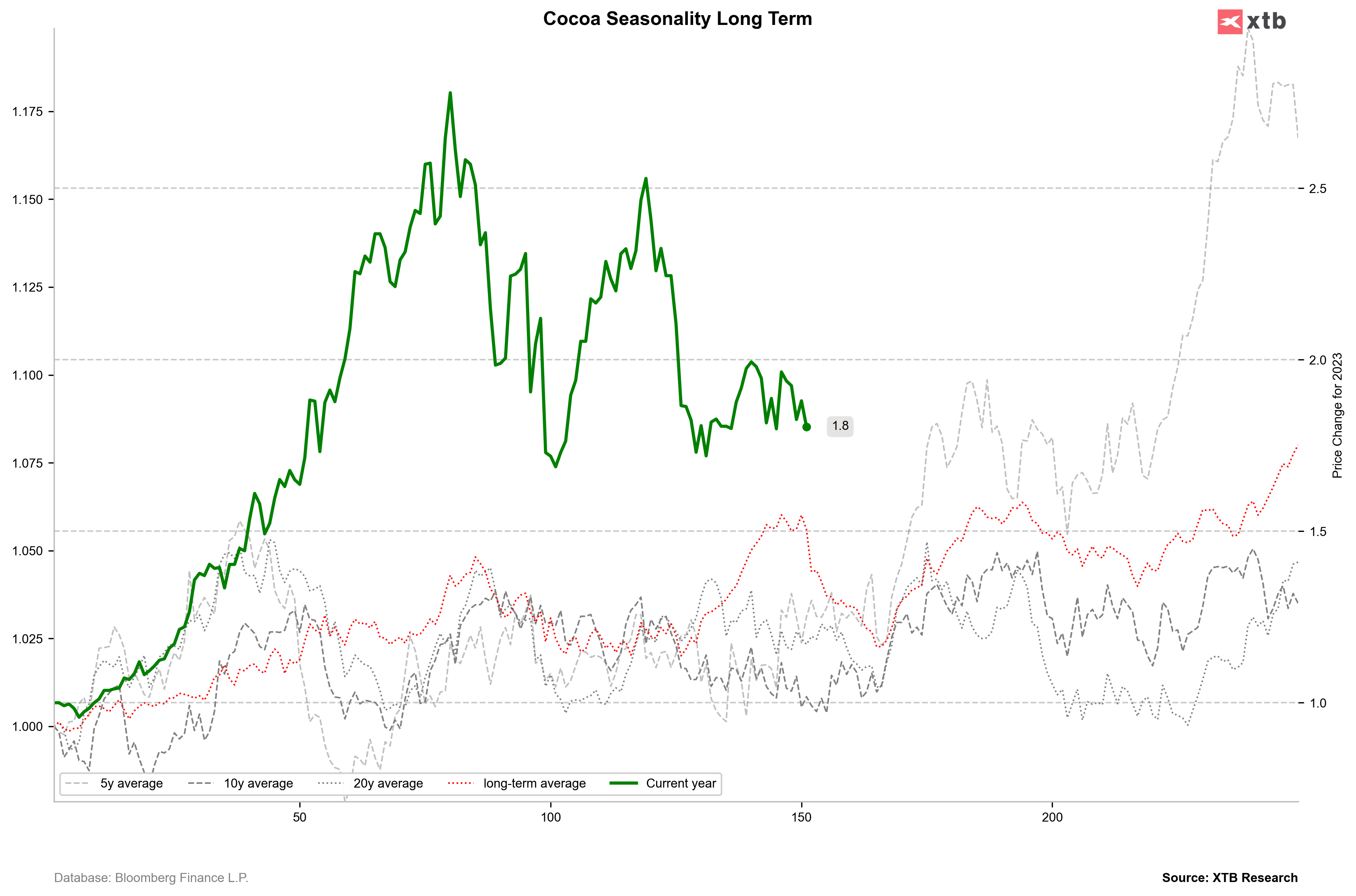 Long-term averages suggest that in the near future, we should expect a price rebound. On the other hand, more and more forecasts indicate a production rebound in the next season. Source: Bloomberg Finance LP, XTB
Long-term averages suggest that in the near future, we should expect a price rebound. On the other hand, more and more forecasts indicate a production rebound in the next season. Source: Bloomberg Finance LP, XTB
Wheat
- Wheat has fallen to its lowest levels in 4 years, which is related to the limited strength of American exports
- Very strong spring wheat harvests are also forecasted in the USA. Yield per acre in North Dakota (a key state for wheat) is expected to be the highest in history
- Wheat is currently the weakest grain in the USA, but in recent days much larger declines have been seen in soybeans
- Speculative positions in soybeans are not changing much, but investors are heavily selling soybeans and corn
- American wheat is currently the cheapest in the world. However, the prices of Russian wheat are also falling, which further pressures American wheat
- The futures curve indicates significant contango, which has been increasing over the past month
- Seasonality shows that, theoretically, a rebound could be expected at the end of August
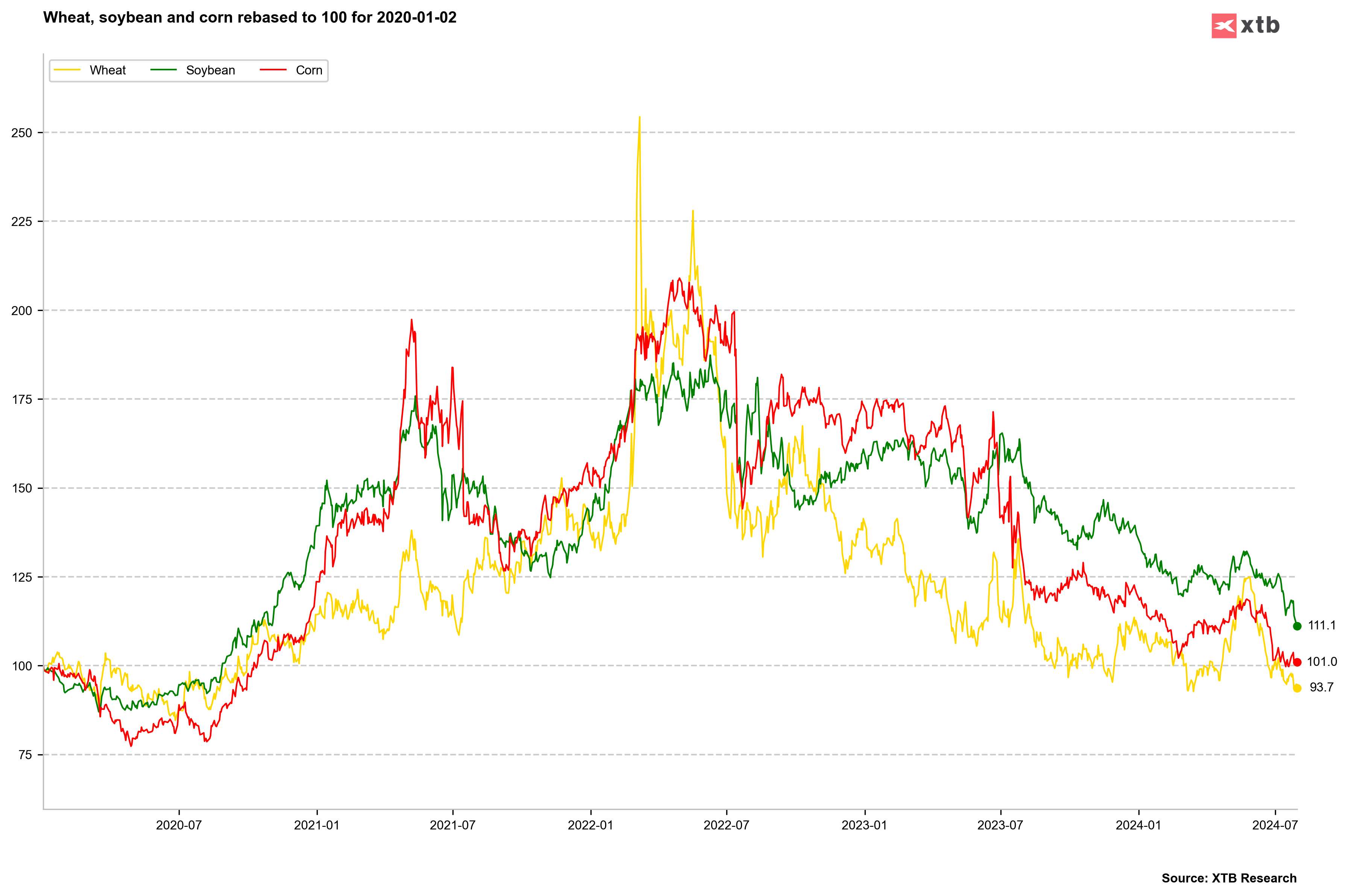 Wheat prices have performed very poorly in recent weeks, but soybeans are being increasingly sold off. Source: Bloomberg Finance LP, XTB
Wheat prices have performed very poorly in recent weeks, but soybeans are being increasingly sold off. Source: Bloomberg Finance LP, XTB
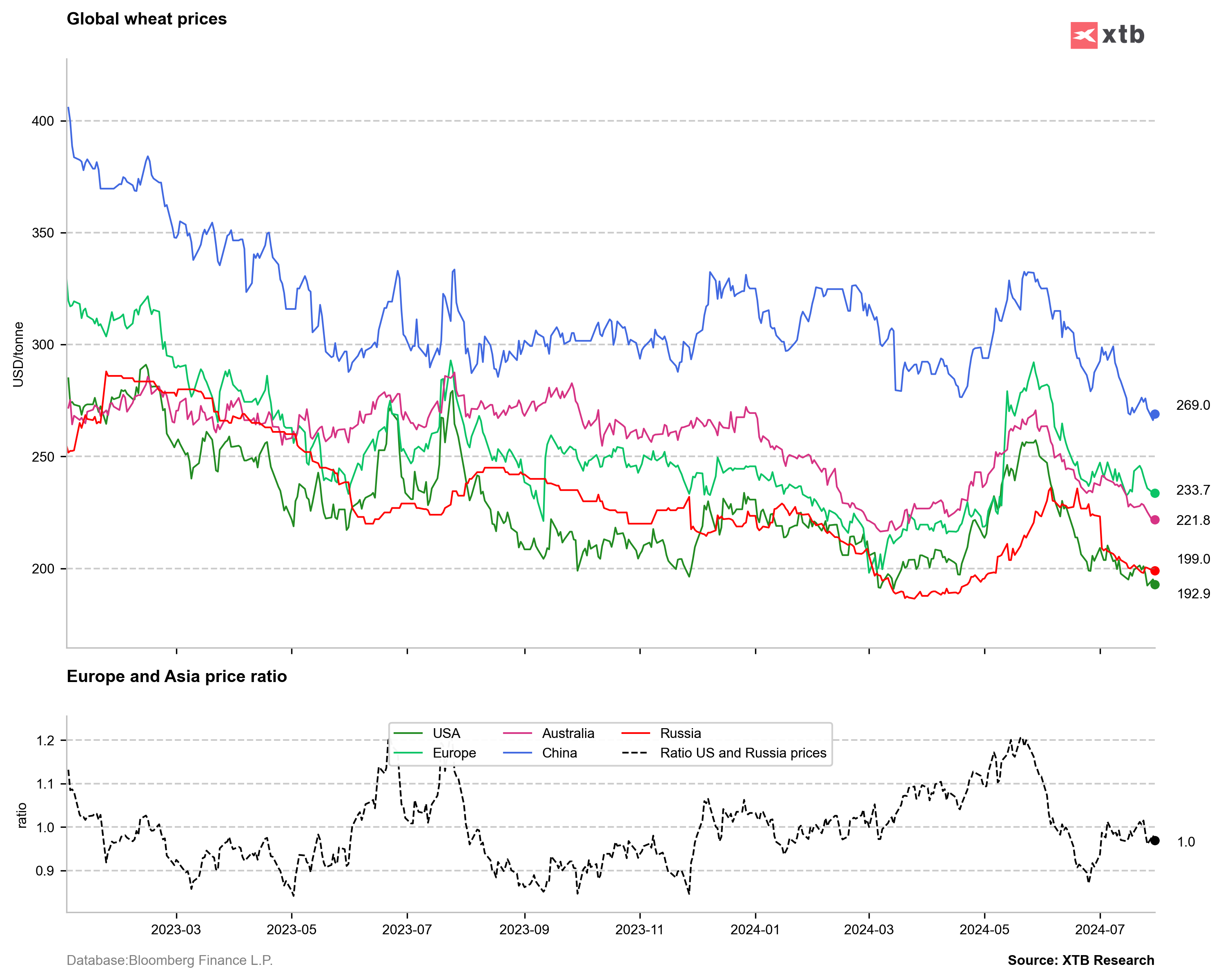 American wheat is currently cheaper than Russian wheat, but the latter is also losing value. Source: Bloomberg Finance LP, XTB
American wheat is currently cheaper than Russian wheat, but the latter is also losing value. Source: Bloomberg Finance LP, XTB
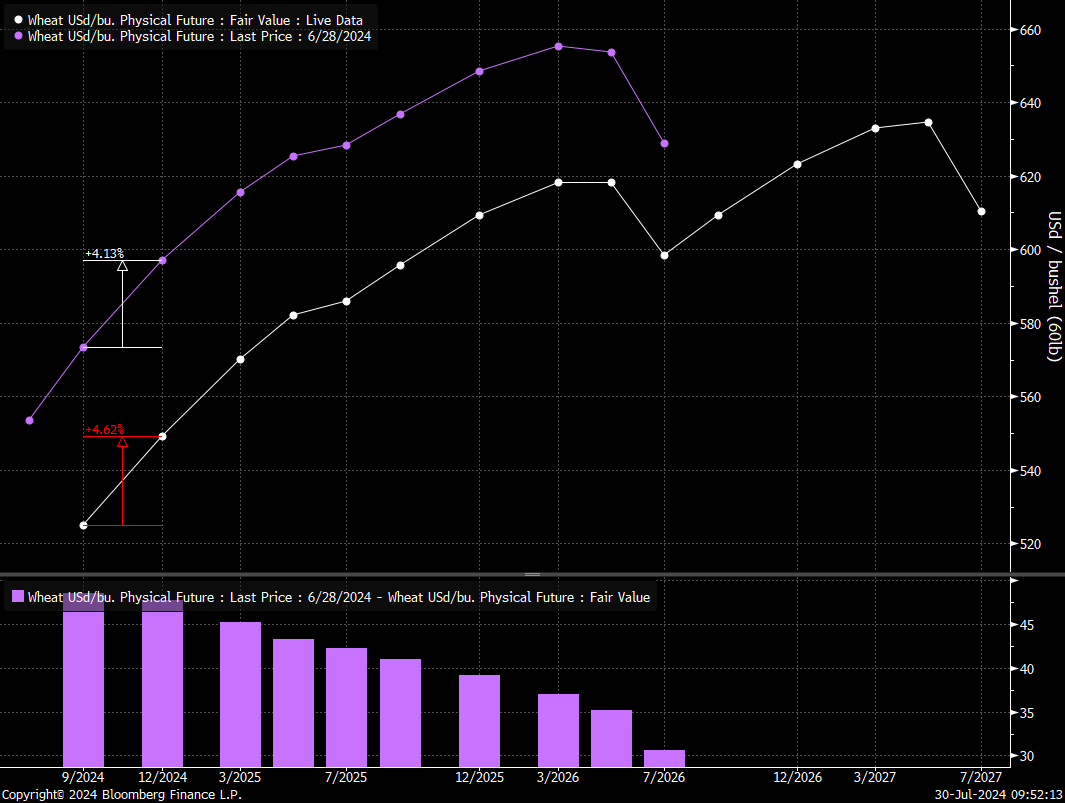 Contango in the market is very pronounced, and the situation is unlikely to change, considering the expectations of substantial spring wheat harvests. Source: Bloomberg Finance LP, XTB
Contango in the market is very pronounced, and the situation is unlikely to change, considering the expectations of substantial spring wheat harvests. Source: Bloomberg Finance LP, XTB
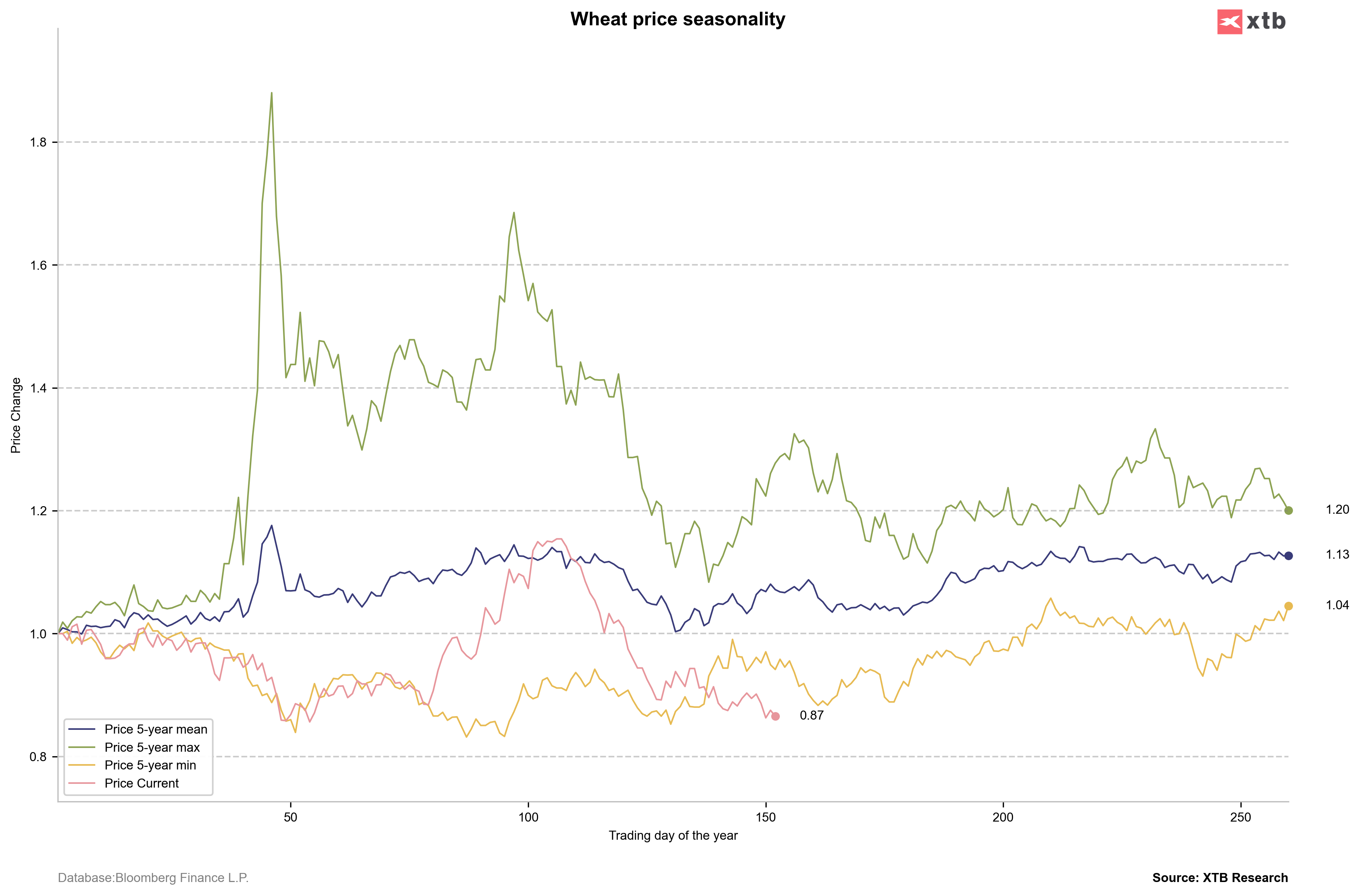 Seasonality shows that wheat has been performing the worst in 5 years. Nevertheless, seasonality also indicates potential improvement at the end of August. Theoretically, the increases should not be very large. Source: Bloomberg Finance LP, XTB
Seasonality shows that wheat has been performing the worst in 5 years. Nevertheless, seasonality also indicates potential improvement at the end of August. Theoretically, the increases should not be very large. Source: Bloomberg Finance LP, XTB
This content has been created by XTB S.A. This service is provided by XTB S.A., with its registered office in Warsaw, at Prosta 67, 00-838 Warsaw, Poland, entered in the register of entrepreneurs of the National Court Register (Krajowy Rejestr Sądowy) conducted by District Court for the Capital City of Warsaw, XII Commercial Division of the National Court Register under KRS number 0000217580, REGON number 015803782 and Tax Identification Number (NIP) 527-24-43-955, with the fully paid up share capital in the amount of PLN 5.869.181,75. XTB S.A. conducts brokerage activities on the basis of the license granted by Polish Securities and Exchange Commission on 8th November 2005 No. DDM-M-4021-57-1/2005 and is supervised by Polish Supervision Authority.

